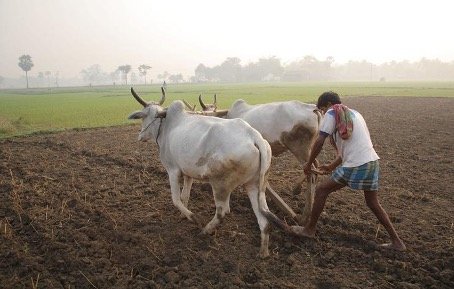 Read this article in French
Read this article in French- Share this article
- Subscribe to our newsletter
Strategic investments are needed to tackling climate challenges in livestock
In a new paper in the journal Nature Sustainability, researchers from the CGIAR's Livestock and Climate Initiative and Wageningen University/the Netherlands have found that investments in only a handful of countries – India, China, Brazil, Pakistan, and Sudan – can make a huge impact for both the Earth and people. Globally, the authors say, changes to the livestock sector have great potential to both mitigate the climate crisis and help people adapt.
Livestock production contributes to climate change and is vulnerable to it at the same time. Ruminant animals' burps and manure release the greenhouse gas methane into the atmosphere, and there are other carbon emissions associated with animal farming as well.
Livestock production directly accounts for 5.8 per cent of global annual greenhouse gas emissions – and closer to 23 per cent including associated deforestation and soil degradation. Animal-based foods represent about one-third of food systems' contribution to global emissions.
But the climate footprint of most livestock-dependent communities in the developing world is vastly smaller than the intensified systems common in developed countries, while climate hazards like droughts, heatwaves and floods disproportionately affect small-scale farmers in the Global South. Keeping farm animals is vital to the livelihoods of almost a billion people in Africa and South Asia. Goats, cows and sheep provide milk and meat, pull ploughs, are deeply woven into cultures and act as a form of insurance in tough times.
"We really don't see a future without livestock," says Jacobo Arango from the Alliance of Bioversity International and the International Center for Tropical Agriculture (CIAT) (The Alliance). "The current livestock systems need to be improved, not gotten rid of. Investors need to start directing money into solutions to transform them."
Any investment in improving these systems has to consider both climate mitigation and adaptation, says Julian Ramirez-Villegas from The Alliance and Wageningen University, something that most investors and countries are not yet doing. "You can't separate the cow that is emitting the greenhouse gas from the cow whose production is affected by climate stress."
In their paper, Arango, Ramirez-Villegas and co-authors analysed both the livestock emissions and climate risks of 132 low- and middle-income countries, and found that almost everywhere, mitigation and adaptation were entangled. They identified India, China, Brazil, Pakistan and Sudan as top-five investment priorities, places with both high emissions and large numbers of people and animals exposed to climate stress. Combined, these five countries account for 46 per cent of the total value of livestock production, 35 per cent of the total rural population exposed to climate hazards, and 51 per cent of livestock greenhouse-gas emissions.
"A handful of countries disproportionately contribute to global livestock emissions," explains co-author Todd S. Rosenstock, from The Alliance – mainly because of their size and large populations. "These act as critical leverage points for the livestock sector's interactions with the climate system, land and livelihoods. Effective mitigation strategies must prioritise investments in sustainable livestock practices in these high-impact regions."
That doesn't let high-income countries off the hook for their farming emissions, or mean investment shouldn't occur in other low-income countries, cautions Ramirez-Villegas. Kenya and Ethiopia, for instance, both scored highly. "It's just that if you transform the way livestock is produced in these five countries, you have the potential to make a very, very big difference in the climate system," he notes.
Livestock production must be decoupled from deforestation
Research already suggests pathways for such transformation. At the most basic level, livestock production must be decoupled from deforestation, says Arango. "We have enough land. Deforestation needs to stop, period. There is no justification for livestock production to come at the expense of forests," he explains. Boosting technical assistance to help farmers to implement rotational grazing systems is also a no-brainer.
Shifting animals' diets to locally-adapted forage plants is more climate-smart than buying commercial feed. And there is potential for methane emissions-reductions without slashing herd sizes, too. CGIAR researchers in Colombia have found that adding forage legumes to traditional grass monocultures can reduce cows' methane emissions by 15 per cent (in the Colombian context).
“These kinds of analyses are critical for us to focus scarce resources in the places and on the topics with maximum potential for impact,” says Andy Jarvis, Director of the Future of Food program at Bezos Earth Fund.
"If livestock producers across the Global South could improve their grazing management and plant trees, and gain access to safety-nets, information, and resources to help them make climate-smart decisions, then I think we would make a dramatic change in both carbon emissions and productivity,” Arango concludes.
(CGIARI/wi)
Reference:
More information:





Add a comment
Be the First to Comment